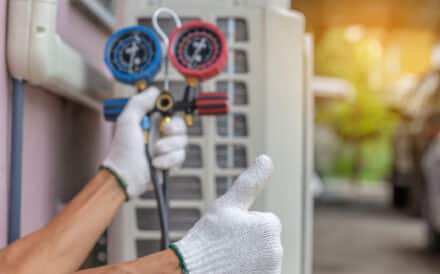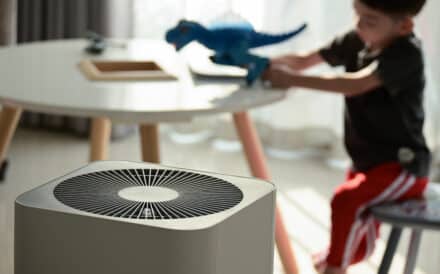The Impact of HVAC Systems on Indoor Plant Health
Did you know? According to the U.S. Environmental Protection Agency, the average American spends around 90% of their time inside! While nothing beats spending time in nature, indoor plants offer so many benefits right where you spend most of your time. They can bring a touch of nature to our living spaces, produce oxygen, absorb toxins and improve indoor air quality, control humidity, and even boost our mental well-being.
As seasons change and temperatures fluctuate, it’s important to ensure your indoor environment can adequately support the health of your indoor plants. And it all begins with your HVAC system. From Monstera to Spider Plants, let’s explore how your HVAC system affects your leafy friends and what you can do to help them flourish in every season.
How Your HVAC System Affects Indoor Plant Health
Your indoor plants may not be able to tell you when something’s wrong, but they can certainly show it via discolored or wilting leaves, stunted growth, or moldy soil. Here are three ways your HVAC system can impact your houseplants.
1. Temperature Fluctuations
Most common houseplants thrive in steady temperatures between 65-75°F. While your HVAC system works to keep your home within a comfortable range, any sudden temperature shifts can put added stress on your plants. So, when your heating kicks on in the winter, or you’ve got your AC blasting on a hot summer day, the quick temperature changes can shock sensitive plants, especially if they reside near vents or registers.
2. Humidity Levels
Where does your HVAC system really make its mark on your indoor plant health? Humidity control. When you run your heater in the winter, it tends to dry out your home’s air, which can be tough on plants that love moisture. During chilly winter months, your indoor humidity can drop below 30%, while most houseplants would be much happier in the 40-60% range. If your plants are showing warning signs like wilty leaves or crispy, dry edges, consider relocating them to a cooler area of your home or a room where you run the heat at a lower temperature.
Your air conditioner has the opposite job in summer. It pulls moisture out of the air as it cools your home. This is great for keeping mold away! But your moisture-loving plants might be left feeling a little parched and thirsting for more humidity.
3. Air Circulation and Quality
Just like you, your plants need to breathe. Good air circulation helps your houseplants grow strong stems and keeps pesky fungal problems at bay. It’s important to avoid placing plants directly in front of vents, as this can cause them to dry out quickly. By filtering out dust and pollutants that might otherwise settle on your plants’ leaves and block the pores plants use for respiration, your HVAC system plays a central role in your indoor plant health, ensuring they have cleaner air to breathe.
Tips for Balancing HVAC Use and Indoor Plant Health
1. Keep Plants in a Safe Spot
Find a good spot for your houseplants away from the direct blast of air vents and registers. Can’t move them? Grab some inexpensive vent deflectors to redirect that airflow elsewhere. Here’s a great pro tip: group your plants together to create micro-environments with higher humidity levels, as plants naturally release moisture through transpiration.
2. Supplement Humidity During the Winter
When your heating system is working overtime in the winter, you can use a humidifier in rooms with many plants, place your plants on trays filled with pebbles and water (which ensures the pot isn’t sitting directly in water), or use a spray bottle to mist humidity-loving plants daily.
3. Schedule HVAC Maintenance
Taking care of your HVAC system will give your whole home a health boost. Regular maintenance can do wonders in extending your system’s lifespan and ensuring better air quality for both you and your plants. When your filters are clean, they catch more dust, debris, and pollutants before they can land on your plants’ leaves and block their ability to breathe. Be sure to schedule bi-annual HVAC maintenance visits to keep your system running efficiently and avoid any unexpected (and costly!) breakdowns.
4. Consider Your Thermostat Settings
Try to keep your home’s temperature from swinging up and down too much. A programmable thermostat can help maintain steady temperatures, which is great news for both indoor plant health and your monthly energy costs. If you spend the day in the office or you’re going on vacation, remember to think about your plants when adjusting your thermostat—too low in the summer or too high in the winter could leave you coming home to some unhappy-looking plants.
Finding the Perfect Balance
With thoughtful adjustments to your HVAC use and plant care routine, you can create an indoor environment where your family’s happy and your plants thrive. Remember that different plants have different needs. For instance, desert plants like cacti and succulents actually prefer the drier air created by heating systems, while tropical plants may need extra humidity care.
If you notice your plants struggling despite your best efforts, it might be time to schedule a check-up for your HVAC system. Our expert technicians can address issues like uneven heating or cooling, excessive dryness, or poor air circulation to ensure your system performs at its best. Contact us today to schedule your visit.




